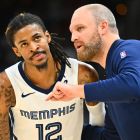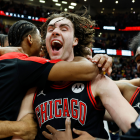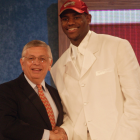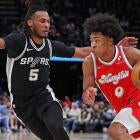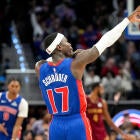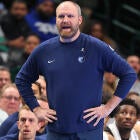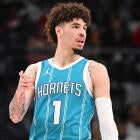The final season for Kobe Bryant is off to a rough start. That's not news to anybody. The Los Angeles Lakers' superstar -- or, former superstar -- has been far below his career standards over the last three seasons, during which he's battled the fabled Father Time and some season-ending injuries. To see one of the greatest players of all time suffer through a tough ending that has his maniacal will turning into acceptance of the end has been sobering.
Though Kevin Durant doesn't want us to dwell on the present Kobe and would rather us celebrate his storied past, it seems nearly impossible to not notice the struggle going on with the Mamba. Kobe's shooting percentage is unfathomably low, he can't lead his team to victories, and those brief, fleeting flashes of actual solid play (like when he dropped 31 on the Wizards the other night) are more pleasant surprises than anything.
Speaking of the Wizards, what we've seen from Kobe in these last few years, if nothing else, has to make you seriously appreciate what Michael Jordan was able to do in those final Washington years from 2001-2003. People love to compare Kobe and Michael, but to even try to compare the two stars' closing chapter to their respectively historic careers is just plain lazy and inaccurate.
The reasons people don't think fondly of Jordan's time with the Wizards are because he was in an unfamiliar uniform, and he wasn't capable of winning a championship in this form. It wasn't the legacy we were used to, so we conflated those years of him in D.C. as subpar. When looking at the context of what Jordan was able to do, his Wizards years were actually quite remarkable.
Jordan hadn't played professional basketball in nearly three years, which meant he presumably hadn't even been training to be in professional basketball shape for at least two years when he decided to come back. He was living the life of a front office executive and while he would still play plenty of casual basketball -- as casual as any competition could be for Jordan -- it's just not the same as the real thing.
At 38 years old, Jordan made his comeback, but the training was cut short by a rib injury he suffered over the summer at the hands (or elbow) of Ron Artest. This, plus the increased workload his body was no longer accustomed to enduring, led to tendinitis in both knees and his wrist, along with back spasms he would deal with occasionally. And yet, he was still able to put up some impressive production and have those big moments.
Only three players have averaged 20 points per game at the age of 38 or older, and Jordan is the only guard to have done it (Karl Malone and Kareem Abdul-Jabbar are the others). Jordan's first year in Washington was a struggle physically, which led to a 41.6 field goal percentage as he averaged 22.9 points, 5.7 rebounds, and 5.2 assists.
He only made it through 60 games before the knees were just too much pain for him, but think about those numbers. Basically 23 points, six boards and five assists. Yes, the efficiency was down, but those would be All-Star numbers right now for any player of any age.
Kobe, for comparison sake, is averaging basically 17 points, four boards and three assists while shooting a painful-to-watch 31 percent from the field -- and somehow he has been even worse than those numbers would seem to indicate.
Back to Jordan. That second year with the Wizards was the lasting impression we were hoping to get. He was healthier and able to train properly during the offseason. Body parts still hurt, but his legs were under him and his strength was able to work in conjunction with a bit more quickness. He shot 44.5 percent that year while scoring 20 points per game, grabbing 6.1 rebounds and dishing out 3.8 assists. Perhaps most impressively, he played all 82 games. This wasn't the championship Jordan we love to remember, and as such, he has, over the years, become a victim of his own greatness, because of course those Washington years could never live up to his own standard. But they were great in their own right.
As you look at Jordan's shot chart from StatMuse, you'll notice that there were still so many areas on the floor where he was productive, well above league average from some spots. He couldn't attack the rim the way he used to, but he peppered defenses with that midrange jumper that was always so lethal. Jordan was a legit weapon, not some wax figure from Madame Tussaud's museum.
Unfortunately, we aren't getting anywhere near this experience with Kobe, and haven't really seen good play out of him since before his Achilles' tendon ruptured in 2013. That's not to knock what Bryant has done, and is still trying to do, and the comparisons to Michael Jordan with him are always a bit tricky. One sect of NBA fans who adore Kobe pine for him to be put in the same light as Jordan -- maybe even as the improved, more modern version. It's simply not the case, but listen, it's not a bad thing to become the gatekeeper to that standard. That isn't failure.
Still, last season Bryant was bad. This season, he's managed to be even worse, mostly because it's improbable to be a guard at the age of 37 or older and have the proper leg strength and endurance to still make an impact. He's tried to make up for it with the simple math equation of taking more 3-pointers, but that just isn't working out. He's never been a great 3-point shooter, and now, with basically no legs under him? Forget it.
As you can see in the chart, there are so many below league average areas for Bryant and not much effectiveness anywhere.
Again, this is less about highlighting how bad Kobe has been and more about properly remembering how good Jordan was able to be at this career point. Part of that could be a much lower mileage (Jordan came back with 43,000 minutes played, while Kobe is over 55,000) on his legs, but Jordan also dealt with atrophy from time off, which can, and did, lead to injuries he had to deal with in his comeback. They just weren't as serious as what Kobe has had to endure, but injuries and sheer wear and tear notwithstanding, there is a stark contrast between what Kobe is doing now and what Jordan did then.
That's what made Bryant's late game heroics in Washington against John Wall and the Wizards so ironic the other night. We saw a flash of the old Kobe while expecting, you know, the old Kobe. After the game and since, Bryant's farewell tour has been met with more acceptance by the Lakers' legend that he is not the player he expects to be, and the internal fire he's become so famous for doesn't burn like it once did. Those one-night Kobe heroics happened, perhaps not coincidentally, in the city where Jordan proved he still had that inferno blazing inside him.
Jordan never had that sendoff tour. He tantalized us with moments of "what if" rather than "what used to be." And that fire never went away, nor did his ability to engulf the competition with it. We're in the middle of a celebration of a Kobe send-off now and for the next few months. It's something we failed to do with Michael during those Wizards years, and something we should be at least more respectful of now when we talk about Jordan's last hurrah.
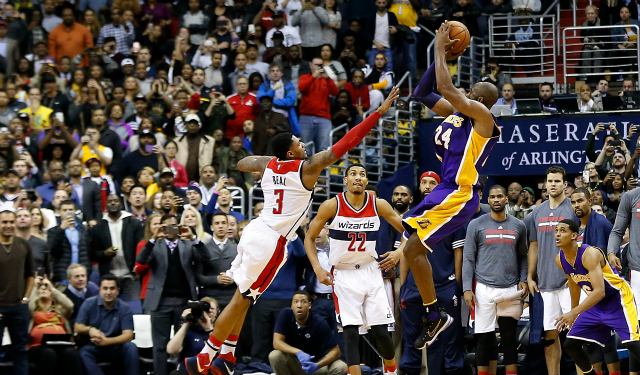
![[object Object] Logo](https://sportshub.cbsistatic.com/i/2020/04/22/e9ceb731-8b3f-4c60-98fe-090ab66a2997/screen-shot-2020-04-22-at-11-04-56-am.png)









